NBN Frequently Asked Questions
- What is the NBN?
- What are Retail Service Providers (RSPs)?
- When is the NBN coming to my area?
- What's the difference between the NBN technologies?
- Which NBN technology is available in my area?
- How do I get connected to the NBN?
- Does somebody need to be on site on installation day?
- What if the NBN is not available at my address?
- Can I change my NBN plan?
- What is the New Development fee?
- How will upgrading to the NBN affect my existing services?
- Will the copper network be disconnected?
- Will my service work during a power outage?
- I'm renting. What do I have to do to get connected to the NBN?
- I live in an apartment block. Will I have access to the NBN?
- Are the speeds provided by the NBN guaranteed?
- Hardware and Wiring
- Phone Services on the NBN
- What phone services are available on the NBN?
- Will my landline phone still work when I switch to the NBN?
- Can I keep my existing telephone number?
- Can I transfer my landline phone number if I already have NodePhone VoIP?
- How do I connect my existing phone to the NBN?
- Will my medical alarm, security alarm, EFTPOS machine, or fax machine work on the NBN?
What is the NBN?
The National Broadband Network (NBN) is a national telecommunications network being built on behalf of the Federal Government. It's changing the way Australians access the Internet, with super-fast fibre, fixed-wireless, hybrid fibre-coaxial, and satellite technology being made available to all Australians.
The NBN is designed to replace or upgrade Australia's existing, ageing copper network, which is no longer sufficient to support our growing demand for faster and more reliable Internet connections. It will be delivered via FTTP (Fibre to the Premises), FTTN (Fibre to the Node), FTTB (Fibre to the Building), FTTC (Fibre to the Curb), HFC (Hybrid Fibre-Coaxial), Fixed-Wireless, and Satellite.
NOTE: Internode does not sell NBN Satellite services.
What are Retail Service Providers (RSPs)?
In the same way you can choose an Internet Service Provider (ISP) for your broadband connection, when the NBN is rolled out in your area you'll need to choose a Retail Service Provider (RSP) to get connected to all NBN-related products (including Internet and phone).
When is the NBN coming to my area?
Check your address using our online coverage checker to see when NBN is coming to your area.
You can also stay informed by registering your interest online. We'll let you know how the roll-out is progressing and when it will become live in your area.
What's the difference between the NBN technologies?
The big difference between the NBN technologies is how the service connects to your premises:
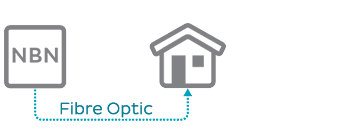 |
Fibre to the Premises (FTTP)In Fibre to the Premises areas, a fibre optic cable connects directly to your premises. The cable terminates at the Premises Connection Device on an outside wall. |
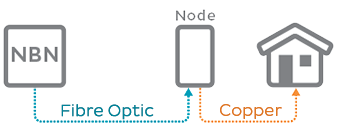 |
Fibre to the Node (FTTN)In Fibre to the Node areas, a fibre optic cable connects to a node in your street (or a street nearby). Copper cabling connects the node to a wall socket in your premises. |
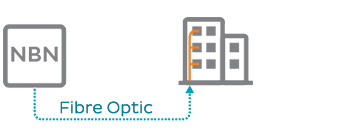 |
Fibre to the Building (FTTB)In Fibre to the Building areas, a fibre optic cable connects to your building's Main Distribution Frame (MDF). The MDF is typically in the basement or in a locked telecommunications cabinet. From there, the MDF connects to a wall socket in your premises using the building's internal copper cabling. |
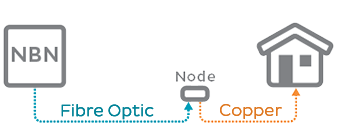 |
Fibre to the Curb (FTTC)In Fibre to the Curb areas, a fibre optic cable connects to a node in a communciations pit in your street. Copper cabling connects the node to a wall socket in your premises. |
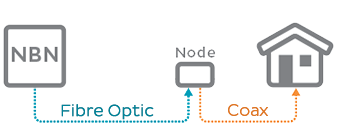 |
Hybrid Fibre-Coaxial (HFC)In HFC areas, a fibre optic cable connects to an optical node, then coaxial cable connects the node to the NBN Network Termination Device in your premises. |
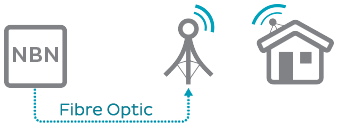 |
Fixed-WirelessIn Fixed-Wireless areas, an antenna installed on your roof will receive a wireless signal from your local NBN fixed-wireless tower. |
Which NBN technology is available in my area?
To find out which technology the NBN will use in your area, check your address.
How do I get connected to the NBN?
So, you've checked your premises on on the coverage checker, and everything seems ready for the NBN. Congratulations!
First you'll need to pick an NBN plan and decide if you want a phone service (a phone service is included with NBN Fibre plans). Once you've figured out your plan, phone service, and any other options, simply sign up online or call us on 13 66 33.
Depending on the NBN technology in your area, you may need to be on site so a technician can install equipment. If this happens, we'll let you know.
Does somebody need to be on site on installation day?
This depends on the type of NBN technology that will be installed, and if any extra work is needed:
- For FTTP, HFC, and Fixed-Wireless connections, you or an authorised representative (aged 18 or older) must be there for the whole appointment. You/They will need to let the technician in, and advise where the equipment should be located.
- For FTTB, FTTN, or FTTC connections, you may not need an appointment. In most cases the NBN installation will be performed outside your premises. However, sometimes attendance is required to check connectivity, install new copper lines, or install wall sockets. We'll let you know if you need to be on site.
What if the NBN is not available at my address?
If the NBN isn't available yet, you can register your interest with Internode.
Once you're registered, we'll keep you up to date with how the roll-out is progressing, and when the NBN will be live in your area. Why constantly check for availability when we can do it for you?
If your area is within 3 months of being ready for service, you can also pre-order your NBN service and we'll process your order as soon as your area goes live!
Can I change my NBN plan?
Certainly! You may switch your NBN plan at any time. There are no contract break or plan change fees to switch plan.
Simply change plan online or contact us if you need help.
What is the New Development fee?
From 1 April 2016, a once-off $300 New Development fee applies to new NBN connections in the following circumstances:
- If your NBN connection is the first connection at a premises in a newly developed area.
For example, if the premises has been built in a suburb with no pre-existing telecommunications infrastructure. - If your NBN connection is the first connection in an established area that has been re-developed to increase the number of dwellings on the same plot of land.
For example, if an existing single house has been demolished to make room for a block of units.
This applies to all NBN connections regardless of the NBN technology used. Once the New Development fee has been charged at an address, it will not be charged again for subsequent connections - provided the number of dwellings at that address has not increased.
At Internode, we pass on the full $300 New Development fee (as billed by our wholesaler, nbn™ co ltd).
How will upgrading to the NBN affect my existing services?
What happens to your existing services will depend on the NBN technology in your area. In most areas, the copper network will either be completely or partially disconnected. In these areas, any phone or ADSL services that use the copper network will also be cancelled.
- In FTTB, FTTC, and FTTN areas, your existing phone and ADSL services will be cancelled automatically when your line is converted to the NBN.
- In FTTP areas, your existing services will usually stay connected when you switch to the NBN, but all copper network services will be disconnected approximately 18 months after the NBN is ready in your area.
- In HFC areas, your existing copper or HFC services will stay connected when you switch, but these will be disconnected approximately 18 months after the NBN is ready in your area.
- In Fixed-Wireless areas, your copper network and existing services will remain connected indefinitely.
If you're migrating an existing Internode service, please let us know if you want to keep your old service active. Otherwise we will automatically cancel your old Internode service within 7 days of your new NBN service becoming active.
Will the copper network be disconnected?
In most areas, services on the copper network will be either completely or partially disconnected.
- In FTTN, FTTC, and FTTB areas, the copper network between the exchange and the node/pit/MDF will be removed.
- In FTTP and HFC areas, all services on the copper network will be disconnected entirely. This will happen approximately 18 months after the NBN is ready in your area.
- In Fixed-Wireless areas, your copper network services will remain connected indefinitely.
Unless you're in a Fixed-Wireless area, you'll need to upgrade to the NBN to stay connected to the Internet or make phone calls. Even if you don't want Internet access, you'll still need to switch to an appropriate NBN phone service to keep making phone calls.
Will my service work during a power outage?
This depends on the type of NBN service you are using. Only NBN FTTP and Fibre Phone services can operate during a power outage - and only if you elected to have a battery back-up unit installed.
In order for an NBN FTTP service to work during a power outage, please be aware that:
- You must have an active battery back-up unit installed.
(You can get this installed at no extra cost when you apply for an NBN FTTP service with Internode). - For use of NBN Fibre Phone you will need a non-powered traditional telephone
Or a telephone with a back-up power supply connected to the voice port on the NBN Network Termination Device (NTD). - Access to the Internet will only be available with a battery powered device (like a laptop).
You will also need to access the Internet by connecting directly to the data port on the NBN Network Termination Device. - During a power outage, the battery will provide power for a limited period of time.
A fully charged battery will last between 3 and 11 hours. If the battery is not fully charged it may last less than 3 hours.
For more information on battery back-up please refer to the user guide supplied by nbn™ co ltd at the time of installation.
I'm renting. What do I have to do to get connected to the NBN?
In most areas you don't need to do anything besides ordering a service. Most services will use your existing copper line and phone sockets, so there's no installation needed.
If you're in a FTTP, HFC, or Fixed-Wireless area, you'll need to secure permission before any installation work can take place. We recommend you speak to your property manager or landlord to obtain permission.
If you are in a FTTP or Fixed-Wireless area - and renting in a share-house situation - there's some good news: The NBN Network Termination Device comes with four data ports (pictured as UNI-D below). This means you can have up to four NBN connections installed at a single premise. One for each person - no more fighting house-mates for quota!
 |
| Figure 2: Data Ports on the NBN FTTP connection box (Network Termination Device) |
I live in an apartment block. Will I have access to the NBN?
You sure will. But make sure that your Body Corporate has registered to be upgraded to the NBN so the design work can be completed.
Are the speeds provided by the NBN guaranteed?
No. All quoted speeds for NBN plans are the wholesale access speeds. However, there are a lot of factors that affect NBN speeds, read about NBN Speeds on our NBN plans page.
Hardware and Wiring
Will my current modem/router work with the NBN?
Yes, as long as it supports the following:
- Broadband:
You will need a router that supports Ethernet (for FTTP, FTTC, HFC, or Fixed-Wireless) or VDSL2 (for FTTB or FTTN). We highly recommend that you have a device that supports both. - Phone services:
For NodePhone VoIP: you will need a router that supports Voice over Internet Protocol (VoIP).
For the NBN Phone service supplied with new NBN Fibre services: you'll need to use the optional Internode WiFi modem. Please note that NBN Phone is only available via the supplied modem.
If you already own a modem/router, we suggest that you check with its manufacturer to see if it is capable of supporting the NBN. If you need a new modem/router that is fully VoIP and NBN compatible, Internode offers compatible hardware.
What equipment do I need?
In addition to a router that supports Ethernet and VDSL2, you may also need NBN equipment installed at your premises.
If you are in a FTTP, FTTC, HFC, or Fixed-Wireless area, you will need NBN equipment installed. The equipment will be supplied to you and/or an NBN technician will install the required equipment at no cost to you. This equipment will also allow one device to connect directly to the active data port via an Ethernet cable.
If you are in a FTTB or FTTN area, you will generally not need any NBN equipment installed. These connections usually use your current telephone socket.
How do I get a WiFi connection with NBN so I can connect other devices?
If you wish to connect your devices via WiFi, then your NBN-ready router must also support WiFi. Be aware that devices connected to your network over WiFi may experience slower speeds than those connected via Ethernet cable.
You'll also need your NBN-capable router to support VoIP if you wish to make and receive calls with NodePhone VoIP.
To use the NBN Phone service included with new NBN Fibre services, you'll need to use the optional modem supplied by Internode. NBN Phone is not available with other modems.
Can I use existing wiring/smart wiring?
You may prefer to have a wired network, especially if WiFi doesn't cover your house from end to end. Wired connections also ensure you get the best speeds when transferring large amounts of data within your network
Your NBN installation does not include wiring beyond the installation of the NBN Network Termination Device (NTD). Any additional wiring is your responsibility. If you would like to have cable installed between rooms of your home, please contact a registered cabler for a quote. A list of registered cablers can be found here.
In-building wiring in new housing estates (FTTP)
If you are considering buying a house in a new housing estate - within a Fibre to the Premises area - nbn™ co ltd (the organisation installing new NBN infrastructure) has a fact sheet about the wiring requirements for new premises in housing developments.
Phone Services on the NBN
What phone services are available on the NBN?
Depending on the NBN service available at your location, there may be different phone service options available.
- NBN Phone is included with NBN Fibre services when you purchase the optional Internode WiFi modem.
- NodePhone VoIP is available on all NBN services. Just make sure your equipment is VoIP (Voice over Internet Protocol) capable.
Will my landline phone still work when I switch to the NBN?
This depends on your NBN connection. In most areas, the copper connection that supports landline phone services will be replaced - either completely or partially - with fibre optic cable. In these cases, your landline phone will be disconnected.
- If you have an NBN FTTP or HFC connection, all services on the copper network will be disconnected 18 months after the NBN passes through your area.
- In NBN Fixed-Wireless areas, your existing copper will remain connected indefinitely.
- If you have an NBN FTTB, FTTN, or FTTC connection, only part of your copper will remain connected. Your landline phone will be automatically cancelled when your copper line is converted to the NBN.
Unless you're in a Fixed-Wireless area, if you want to continue using your phone number, you'll need to transfer it to one of our NBN phone options:
- NBN Phone is included with NBN Fibre services when you purchase the optional Internode WiFi modem.
- NodePhone VoIP is available on all NBN services. Just make sure your equipment is VoIP (Voice over Internet Protocol) capable.
Can I keep my existing telephone number?
Yes, in most cases we can bring your existing telephone number over to the NBN.
We understand that moving to a new network isn't always easy so our technical gurus use a process called LNP (Local Number Portability in full) to remove the hassle. There are a few things we need to check before bringing your phone number over, but leave that to us. Just call our friendly Sales team on 13 66 33 to discuss further.
Can I transfer my landline phone number if I already have NodePhone VoIP?
Yes, it's possible to run both services simultaneously. Please call our Sales team on 13 66 33 for assistance.
How do I connect my existing phone to the NBN?
In most cases you will be able to plug your existing handset or base station into a VoIP port on your NBN-capable router. You will need a router that supports Voice over IP to make and receive calls over the Internet. If you don't have a VoIP-capable router, we can help you out.
If you have NBN Phone (available with new NBN Fibre services when you purchase the optional Internode modem), you can plug your phone into the phone port on the supplied modem.
If you prefer to have wired phone sockets in several locations around your home you'll need to have them wired so that you can connect them to the phone port on your NBN device. Please note that this is your responsibility and a registered cabler must do this work. You can find a list of registered cablers here.
Will my medical alarm, security alarm, EFTPOS machine, or fax machine
work on the NBN?
Many devices that normally connect to phone lines (such as medical and security alarms, EFTPOS, and more) can work over the NBN.
It is important that you contact your device's provider before ordering an NBN phone service. They will be able to discuss with you if your device is suitable, and offer replacements if needed.
Depending on the service, you may also need to register the device with nbn™ co ltd. It's also important that you confirm the type of NBN service that is required, and that your device has been tested to confirm that it works on the NBN technology available to you.
| Device | What you need to do |
|---|---|
| Medical Alarm (including professionally monitored medical alarms, auto-diallers, and emergency call buttons) |
|
| EFTPOS and Health Claims terminals |
|
| Security Alarm |
|
| Lift emergency phone or Fire indicator panel |
|
Important note about Priority Assistance
We do not offer priority assistance, nor support for medi-alert services and monitored alarm systems. Priority assistance is offered by Telstra for people who may be reliant on a telephone service because of a serious medical condition. If you have a medi-alert or priority assistance service or believe that you are eligible, please consider this before proceeding with your order.

